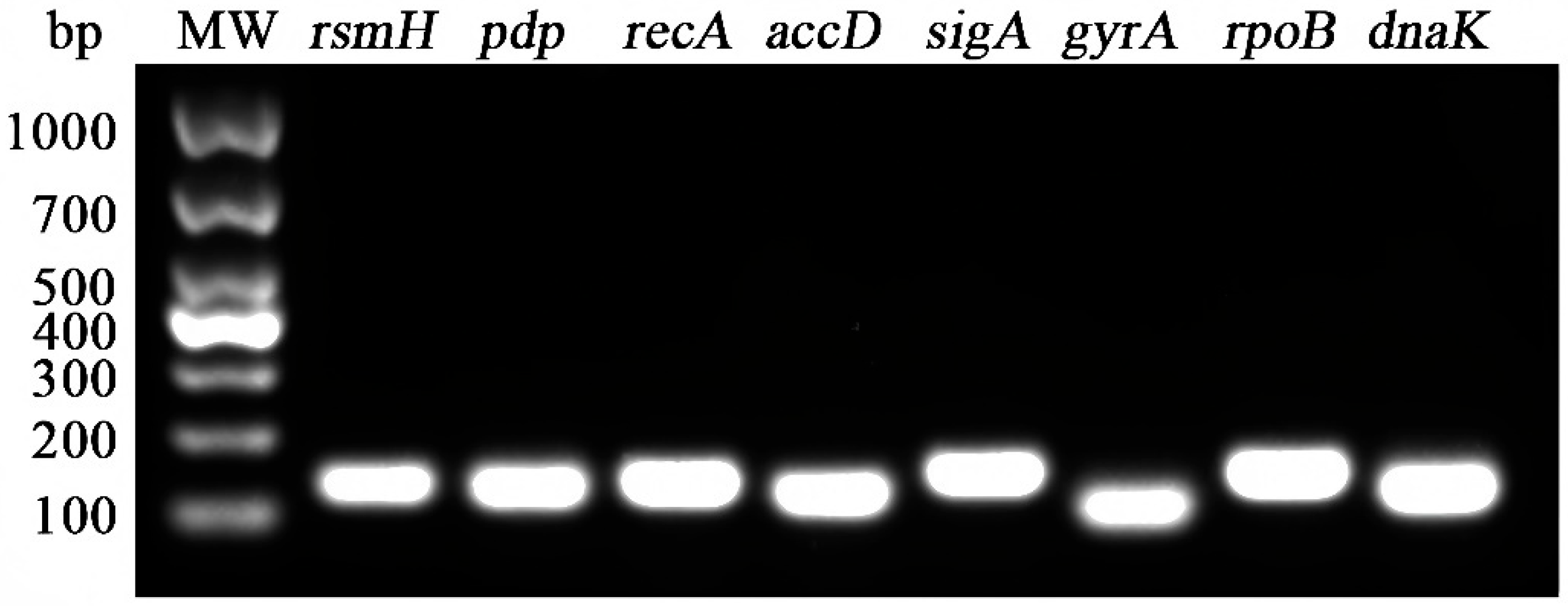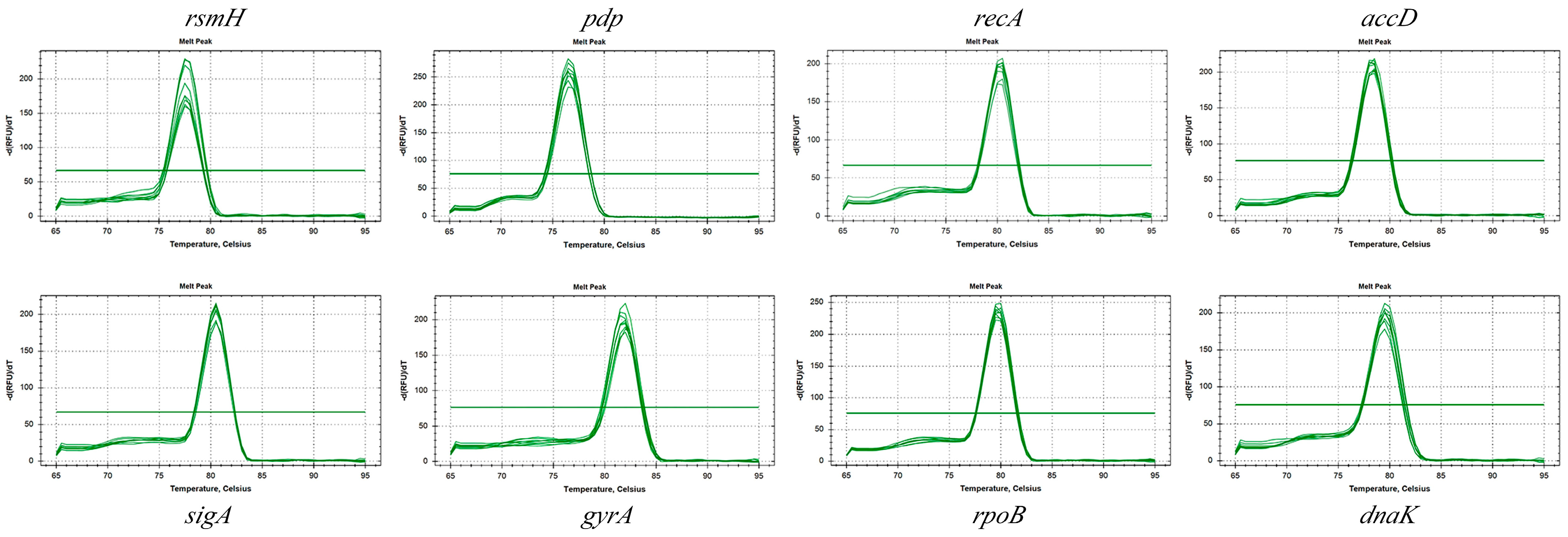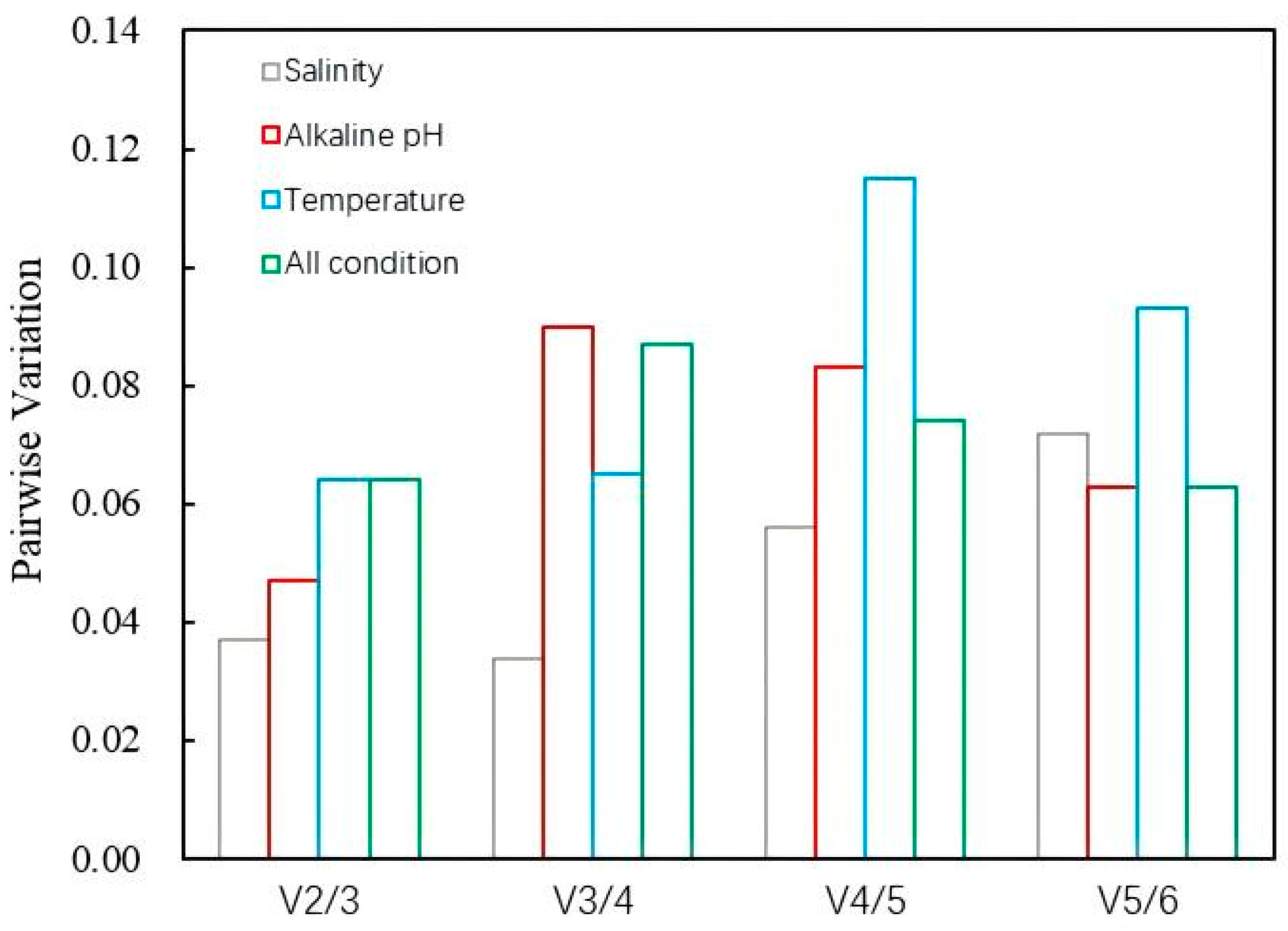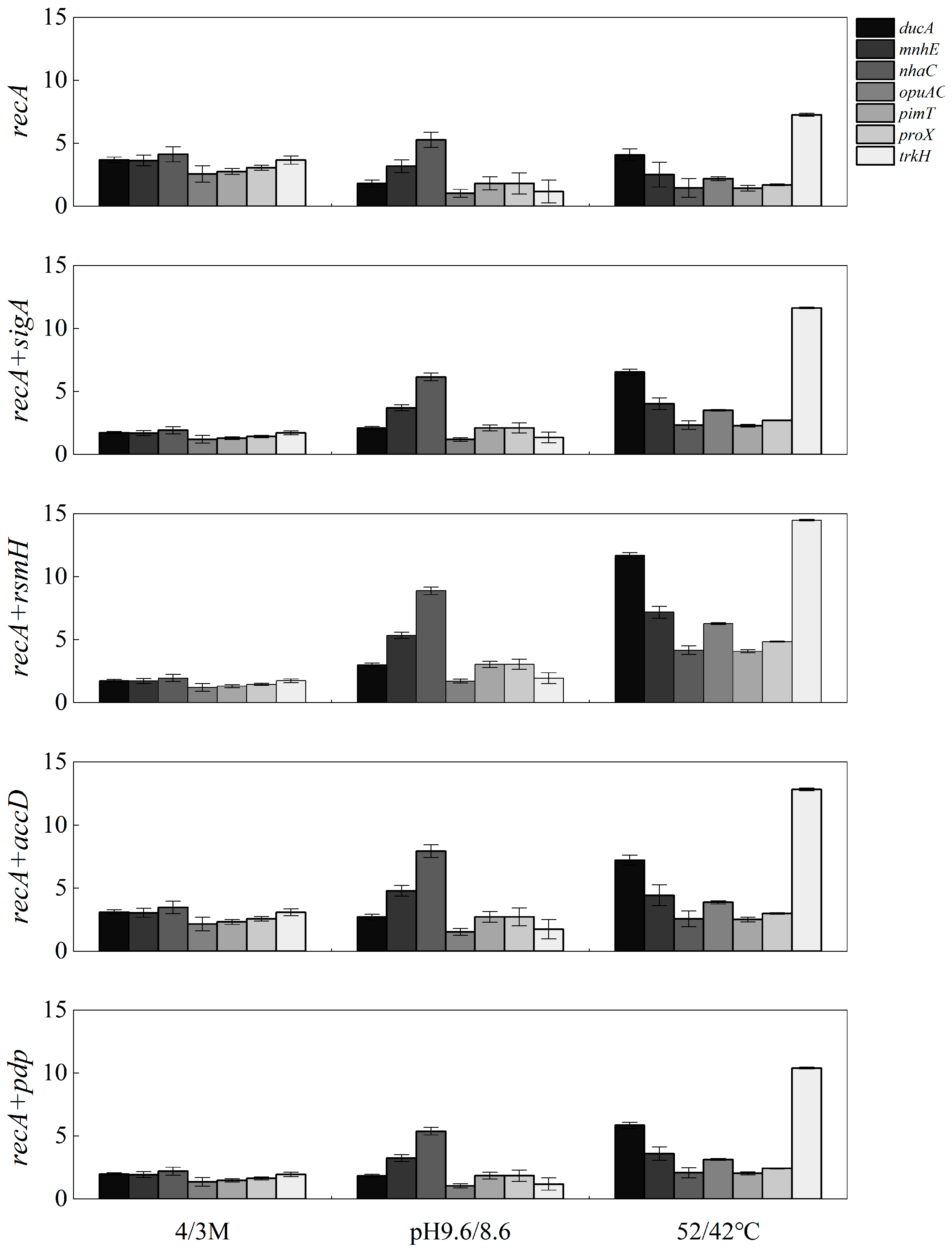Quantitative Evaluation of Endogenous Reference Genes for RT-qPCR and ddPCR Gene Expression Under Polyextreme Conditions Using Anaerobic Halophilic Alkalithermophile Natranaerobius thermophilus
Abstract
1. Introduction
2. Materials and Methods
2.1. Bacterial Strains and Growth Conditions
2.2. Total RNA Extraction and cDNA Synthesis
2.3. Selection of Candidate Genes and Primer Design
2.4. RT-qPCR Efficiency and Assays
2.5. Stability of Gene Expression and Minimum Number of RGs
2.6. Validation of the Selected RGs
3. Results
3.1. Amplification Efficiency of Candidate RGs
3.2. Candidate RGs Expression Levels
3.3. Expression Stability of Candidate RGs
3.4. GeNorm Analysis
3.5. NormFinder Analysis
3.6. BestKeeper Analysis
3.7. RefFinder Analysis
3.8. Validation of the Selected RGs
4. Discussion
5. Conclusions
Supplementary Materials
Author Contributions
Funding
Institutional Review Board Statement
Informed Consent Statement
Data Availability Statement
Acknowledgments
Conflicts of Interest
References
- Lian, C.; Zhang, B.; Yang, J.; Lan, J.; Yang, H.; Guo, K.; Li, J.; Chen, S. Validation of Suitable Reference Genes by Various Algorithms for Gene Expression Analysis in Isodon Rubescens under Different Abiotic Stresses. Sci. Rep. 2022, 12, 19599. [Google Scholar] [CrossRef] [PubMed]
- Umadevi, P.; Suraby, E.J.; Anandaraj, M.; Nepolean, T. Identification of Stable Reference Gene for Transcript Normalization in Black Pepper-Phytophthora Capsici Pathosystem. Physiol. Mol. Biol. Plants 2019, 25, 945–952. [Google Scholar] [CrossRef] [PubMed]
- Bustin, S.A.; Beaulieu, J.-F.; Huggett, J.; Jaggi, R.; Kibenge, F.S.; Olsvik, P.A.; Penning, L.C.; Toegel, S. MIQE Précis: Practical Implementation of Minimum Standard Guidelines for Fluorescence-Based Quantitative Real-Time PCR Experiments. BMC Mol. Biol. 2010, 11, 74. [Google Scholar] [CrossRef] [PubMed]
- Sinha, R.; Sharma, T.R.; Singh, A.K. Validation of Reference Genes for qRT-PCR Data Normalisation in Lentil (Lens culinaris) under Leaf Developmental Stages and Abiotic Stresses. Physiol. Mol. Biol. Plants 2019, 25, 123–134. [Google Scholar] [CrossRef] [PubMed]
- Zhao, G.; Wang, M.; Gan, Y.; Gong, H.; Li, J.; Zheng, X.; Liu, X.; Zhao, S.; Luo, J.; Wu, H. Identification of Suitable Reference Genes for Quantitative Reverse Transcription PCR in Luffa (Luffa cylindrica). Physiol. Mol. Biol. Plants 2022, 28, 737–747. [Google Scholar] [CrossRef] [PubMed]
- González-Bermúdez, L.; Anglada, T.; Genescà, A.; Martín, M.; Terradas, M. Identification of Reference Genes for RT-qPCR Data Normalisation in Aging Studies. Sci. Rep. 2019, 9, 13970. [Google Scholar] [CrossRef] [PubMed]
- Zhang, Y.; Gong, Z.; Li, L.; Niu, L.; Fu, Y. Evaluation of Endogenous Reference Genes in Bactrocera Cucurbitae by qPCR under Different Conditions. PLoS ONE 2018, 13, e0202829. [Google Scholar] [CrossRef] [PubMed]
- Rocha, D.J.P.; Santos, C.S.; Pacheco, L.G.C. Bacterial Reference Genes for Gene Expression Studies by RT-qPCR: Survey and Analysis. Antonie Van Leeuwenhoek 2015, 108, 685–693. [Google Scholar] [CrossRef] [PubMed]
- Liu, L.; Ji, Z.; Zhao, K.; Zhao, Y.; Zhang, Y.; Huang, S. Validation of Housekeeping Genes as Internal Controls for Gene Expression Studies on Biofilm Formation in Bacillus velezensis. Appl. Microbiol. Biotechnol. 2022, 106, 2079–2089. [Google Scholar] [CrossRef] [PubMed]
- Lin, J.; Redies, C. Histological Evidence: Housekeeping Genes Beta-Actin and GAPDH Are of Limited Value for Normalization of Gene Expression. Dev. Genes Evol. 2012, 222, 369–376. [Google Scholar] [CrossRef] [PubMed]
- García-Laviña, C.X.; Castro-Sowinski, S.; Ramón, A. Reference Genes for Real-Time RT-PCR Expression Studies in an Antarctic Pseudomonas Exposed to Different Temperature Conditions. Extremophiles 2019, 23, 625–633. [Google Scholar] [CrossRef] [PubMed]
- de Oliveira, P.A.A.; Baboghlian, J.; Ramos, C.O.A.; Mançano, A.S.F.; de Melo Porcari, A.; Girardello, R.; Ferraz, L.F.C. Selection and Validation of Reference Genes Suitable for Gene Expression Analysis by Reverse Transcription Quantitative Real-Time PCR in Acinetobacter Baumannii. Sci. Rep. 2024, 14, 3830. [Google Scholar] [CrossRef] [PubMed]
- Xing, Q.; Mesbah, N.M.; Wang, H.; Li, J.; Zhao, B. Quantitative Evaluation of Endogenous Reference Genes for ddPCR under Salt Stress Using a Moderate Halophile. Extremophiles 2023, 27, 8. [Google Scholar] [CrossRef] [PubMed]
- Mesbah, N.M.; Hedrick, D.B.; Peacock, A.D.; Rohde, M.; Wiegel, J. Natranaerobius thermophilus Gen. Nov., Sp. Nov., a Halophilic, Alkalithermophilic Bacterium from Soda Lakes of the Wadi An Natrun, Egypt, and Proposal of Natranaerobiaceae Fam. Nov. and Natranaerobiales Ord. Nov. Int. J. Syst. Evol. Microbiol. 2007, 57, 2507–2512. [Google Scholar] [CrossRef] [PubMed]
- Xing, Q.; Zhang, S.; Tao, X.; Mesbah, N.M.; Mao, X.; Wang, H.; Wiegel, J.; Zhao, B. The Polyextremophile Natranaerobius Thermophilus Adopts a Dual Adaptive Strategy to Long-Term Salinity Stress, Simultaneously Accumulating Compatible Solutes and K+. Appl. Environ. Microbiol. 2024, 90, e00145-24. [Google Scholar] [CrossRef] [PubMed]
- Aviv, G.; Gal-Mor, O. Real-Time Reverse Transcription PCR as a Tool to Study Virulence Gene Regulation in Bacterial Pathogens. In Host-Pathogen Interactions: Methods and Protocols; Medina, C., López-Baena, F.J., Eds.; Springer: New York, NY, USA, 2018; pp. 23–32. ISBN 978-1-4939-7604-1. [Google Scholar]
- Shinohara, T.; Ikawa, S.; Iwasaki, W.; Hiraki, T.; Hikima, T.; Mikawa, T.; Arai, N.; Kamiya, N.; Shibata, T. Loop L1 Governs the DNA-Binding Specificity and Order for RecA-Catalyzed Reactions in Homologous Recombination and DNA Repair. Nucleic Acids Res. 2015, 43, 973–986. [Google Scholar] [CrossRef] [PubMed]
- Li, X.; Gong, P.; Wang, B.; Wang, C.; Li, M.; Zhang, Y.; Li, X.; Gao, H.; Ju, J.; Zhu, X. Selection and Validation of Experimental Condition-Specific Reference Genes for qRT-PCR in Metopolophium dirhodum (Walker) (Hemiptera: Aphididae). Sci. Rep. 2020, 10, 21951. [Google Scholar] [CrossRef] [PubMed]
- Wang, M.; Ren, T.; Marowa, P.; Du, H.; Xu, Z. Identification and Selection of Reference Genes for Gene Expression Analysis by Quantitative Real-Time PCR in Suaeda Glauca’s Response to Salinity. Sci. Rep. 2021, 11, 8569. [Google Scholar] [CrossRef] [PubMed]
- Ma, Y.; Sun, X.; Xu, X.; Zhao, Y.; Pan, Y.; Hwang, C.-A.; Wu, V.C.H. Investigation of Reference Genes in Vibrio Parahaemolyticus for Gene Expression Analysis Using Quantitative RT-PCR. PLoS ONE 2015, 10, e0144362. [Google Scholar] [CrossRef] [PubMed]
- Shiro, S.; Kuranaga, C.; Yamamoto, A.; Sameshima-Saito, R.; Saeki, Y. Temperature-Dependent Expression of NodC and Community Structure of Soybean-Nodulating Bradyrhizobia. Microbes Environ. 2016, 31, 27–32. [Google Scholar] [CrossRef] [PubMed]







| Gene Name | Slope | Efficiency (%) | Correlation (R2) |
|---|---|---|---|
| rsmH | −3.129 | 108.7 | 0.996 |
| pdp | −3.303 | 100.8 | 0.986 |
| recA | −3.387 | 97.3 | 0.997 |
| accD | −3.437 | 95.4 | 0.997 |
| sigA | −3.513 | 92.6 | 0.999 |
| gyrA | −3.529 | 92.0 | 0.999 |
| rpoB | −3.579 | 90.3 | 0.999 |
| dnaK | −3.451 | 94.9 | 0.999 |
| Method | Rank | Salinity | Temperature | Alkaline pH | All Condition | ||||
|---|---|---|---|---|---|---|---|---|---|
| Gene Name | Value | Gene Name | Value | Gene Name | Value | Gene Name | Value | ||
| Comparative Ct STDEV | 1 | recA | 0.34 | pdp | 2.27 | pdp | 2.03 | recA | 0.41 |
| 2 | sigA | 0.34 | accD | 2.28 | recA | 2.04 | sigA | 0.45 | |
| 3 | pdp | 0.36 | sigA | 2.31 | gyrA | 2.08 | dnaK | 0.47 | |
| 4 | rsmH | 0.36 | recA | 2.48 | sigA | 2.08 | pdp | 0.48 | |
| 5 | rpoB | 0.40 | rsmH | 2.73 | rsmH | 2.15 | accD | 0.48 | |
| 6 | gyrA | 0.52 | gyrA | 2.74 | accD | 2.40 | rsmH | 0.53 | |
| 7 | dnaK | 0.75 | rpoB | 4.88 | rpoB | 4.61 | gyrA | 0.68 | |
| 8 | accD | 0.75 | dnaK | 8.53 | dnaK | 8.36 | rpoB | 0.86 | |
| geNorm average expression stability values M | 1 | rsmH|recA | 0.11 | pdp|sigA | 0.32 | pdp|recA | 0.12 | recA|sigA | 0.18 |
| 2 | sigA | 0.12 | accD | 0.34 | sigA | 0.21 | pdp | 0.20 | |
| 3 | pdp | 0.13 | recA | 0.50 | gyrA | 0.29 | dnaK | 0.28 | |
| 4 | rpoB | 0.19 | gyrA | 0.68 | rsmH | 0.36 | accD | 0.33 | |
| 5 | gyrA | 0.28 | rsmH | 0.84 | accD | 0.48 | rsmH | 0.37 | |
| 6 | dnaK | 0.39 | rpoB | 1.86 | rpoB | 1.51 | gyrA | 0.44 | |
| 7 | accD | 0.48 | dnaK | 3.53 | dnaK | 3.22 | rpoB | 0.55 | |
| NormFinder stability value SV | 1 | recA | 0.05 | accD | 0.17 | recA | 0.50 | recA | 0.15 |
| 2 | pdp | 0.06 | pdp | 0.51 | pdp | 0.51 | dnaK | 0.21 | |
| 3 | sigA | 0.06 | sigA | 0.55 | sigA | 0.65 | accD | 0.25 | |
| 4 | rsmH | 0.13 | recA | 1.03 | gyrA | 0.70 | sigA | 0.26 | |
| 5 | rpoB | 0.14 | rsmH | 1.57 | rsmH | 0.94 | pdp | 0.33 | |
| 6 | gyrA | 0.40 | gyrA | 1.95 | accD | 1.45 | rsmH | 0.35 | |
| 7 | dnaK | 0.73 | rpoB | 3.76 | rpoB | 3.59 | gyrA | 0.58 | |
| 8 | accD | 0.73 | dnaK | 8.36 | dnaK | 8.21 | rpoB | 0.80 | |
| BestKeeper SD [±CP] | 1 | dnaK | 0.30 | recA | 0.29 | recA | 0.33 | gyrA | 0.62 |
| 2 | gyrA | 0.55 | gyrA | 0.68 | sigA | 0.40 | pdp | 0.71 | |
| 3 | rpoB | 0.84 | pdp | 0.74 | pdp | 0.41 | sigA | 0.81 | |
| 4 | pdp | 0.97 | sigA | 0.87 | gyrA | 0.61 | recA | 0.85 | |
| 5 | recA | 0.99 | accD | 0.97 | accD | 0.66 | dnaK | 0.89 | |
| 6 | sigA | 1.01 | rsmH | 1.74 | rsmH | 0.79 | accD | 1.09 | |
| 7 | rsmH | 1.06 | rpoB | 2.37 | rpoB | 1.39 | rsmH | 1.19 | |
| 8 | accD | 1.54 | dnaK | 5.03 | dnaK | 4.93 | rpoB | 1.28 | |
| RefFinder geomean of ranking values | 1 | recA | 1.50 | pdp|sigA | 0.32 | recA | 1.19 | recA | 1.41 |
| 2 | pdp | 3.13 | accD | 0.34 | pdp | 1.57 | sigA | 2.21 | |
| 3 | sigA | 3.22 | recA | 0.50 | sigA | 2.91 | pdp | 3.31 | |
| 4 | rsmH | 3.25 | gyrA | 0.68 | gyrA | 3.72 | dnaK | 3.31 | |
| 5 | dnaK | 4.30 | rsmH | 0.84 | rsmH | 5.23 | gyrA | 4.30 | |
| 6 | rpoB | 4.40 | rpoB | 1.86 | accD | 5.73 | accD | 4.61 | |
| 7 | gyrA | 4.56 | dnaK | 3.53 | rpoB | 7.00 | rsmH | 6.24 | |
| 8 | accD | 8.00 | dnaK | 8.00 | rpoB | 8.00 |
Disclaimer/Publisher’s Note: The statements, opinions and data contained in all publications are solely those of the individual author(s) and contributor(s) and not of MDPI and/or the editor(s). MDPI and/or the editor(s) disclaim responsibility for any injury to people or property resulting from any ideas, methods, instructions or products referred to in the content. |
© 2025 by the authors. Licensee MDPI, Basel, Switzerland. This article is an open access article distributed under the terms and conditions of the Creative Commons Attribution (CC BY) license (https://creativecommons.org/licenses/by/4.0/).
Share and Cite
Tao, X.; Xing, Q.; Zhang, Y.; Atnkut, B.; Wei, H.; Ramirez, S.; Mao, X.; Zhao, B. Quantitative Evaluation of Endogenous Reference Genes for RT-qPCR and ddPCR Gene Expression Under Polyextreme Conditions Using Anaerobic Halophilic Alkalithermophile Natranaerobius thermophilus. Microorganisms 2025, 13, 1721. https://doi.org/10.3390/microorganisms13081721
Tao X, Xing Q, Zhang Y, Atnkut B, Wei H, Ramirez S, Mao X, Zhao B. Quantitative Evaluation of Endogenous Reference Genes for RT-qPCR and ddPCR Gene Expression Under Polyextreme Conditions Using Anaerobic Halophilic Alkalithermophile Natranaerobius thermophilus. Microorganisms. 2025; 13(8):1721. https://doi.org/10.3390/microorganisms13081721
Chicago/Turabian StyleTao, Xinyi, Qinghua Xing, Yingjie Zhang, Belsti Atnkut, Haozhuo Wei, Silva Ramirez, Xinwei Mao, and Baisuo Zhao. 2025. "Quantitative Evaluation of Endogenous Reference Genes for RT-qPCR and ddPCR Gene Expression Under Polyextreme Conditions Using Anaerobic Halophilic Alkalithermophile Natranaerobius thermophilus" Microorganisms 13, no. 8: 1721. https://doi.org/10.3390/microorganisms13081721
APA StyleTao, X., Xing, Q., Zhang, Y., Atnkut, B., Wei, H., Ramirez, S., Mao, X., & Zhao, B. (2025). Quantitative Evaluation of Endogenous Reference Genes for RT-qPCR and ddPCR Gene Expression Under Polyextreme Conditions Using Anaerobic Halophilic Alkalithermophile Natranaerobius thermophilus. Microorganisms, 13(8), 1721. https://doi.org/10.3390/microorganisms13081721







